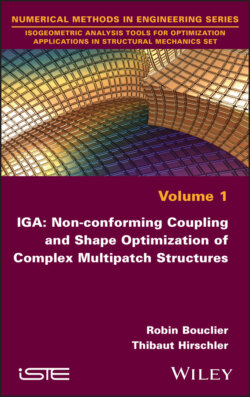Читать книгу IGA - Robin Bouclier - Страница 32
1.5.1. Governing equations
ОглавлениеWe consider here, the simple case of a bi-domain linear elastic problem in Ω ⊂ ℝd, d = 2 or 3 being the parametric dimension of the domain. More precisely, Ω is divided into two disjoint, open and bounded subsets Ω1 and Ω2, joining at interface Γ (see Figure 1.22). In other words, we have Ω = Ω1 ∪ Ω2 ∪ Γ and Ω1 ∩ Ω2 = ∅. We assume that the two non-overlapping sub-domains Ω1 and Ω2 are subjected to body forces respectively. Furthermore, forces are associated with boundaries ΓF1 and ΓF2, and displacements are prescribed over boundaries Γu1 and Γu2, respectively. The boundaries satisfy the following relations for m ∈ {1, 2} (see Figure 1.22):
[1.34]
In each sub-domain, the kinematic constraints, the equilibrium equations and the constitutive relations have to be verified. Using again, the subscript m to denote a quantity that is valid over region Ωm (with m ∈ {1, 2}), the corresponding governing equations read:
[1.35a]
[1.35b]
[1.35c]
[1.35d]
Figure 1.22. Reference domain coupling problem. For a color version of this figure, see www.iste.co.uk/bouclier/IGA.zip
In the above equations, ε (um) denotes the infinitesimal strain tensors, σm denotes the Cauchy stress tensors, Cm denotes the Hooke tensors and nm represents the outward unit normal to Ωm. We specify here that we perform, as follows, the notations in the document: continuous quantities are in normal type, while discrete quantities (i.e. vectors and matrices) are in boldface type (see equation [1.33]). To complete the formulation of the boundary value problem, the interface condition has to be added:
[1.36a]
[1.36b]
It ensures the kinematic compatibility and equilibrium of the tractions, respectively, along the coupling interface Γ between the two sub-domains. Combining conditions [1.36] with local equations [1.35] is strictly equivalent to a linear elasticity problem posed over the whole initial domain Ω. In the case of arbitrary non-matching and non-conforming interfaces, the coupling conditions cannot be imposed in a strong way. Instead, those coupling conditions are prescribed in the weak sense, and thus, the coupling methods differ by the way those weak conditions are formulated.
